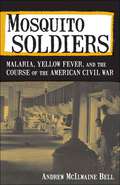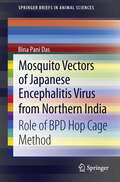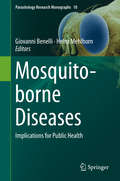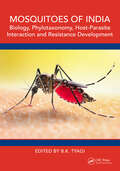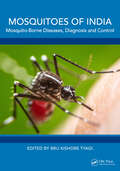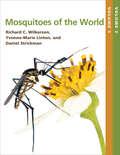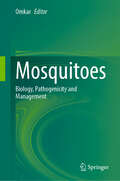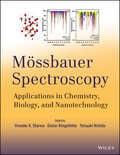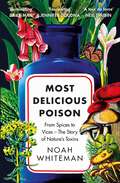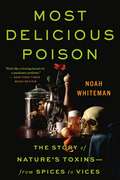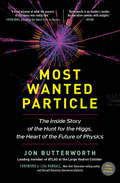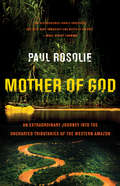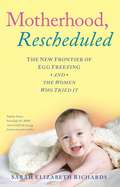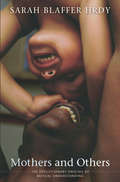- Table View
- List View
Mosquito Soldiers: Malaria, Yellow Fever, and the Course of the American Civil War
by Andrew Mcilwaine BellOf the 620,000 soldiers who perished during the American Civil War, the overwhelming majority died not from gunshot wounds or saber cuts, but from disease. And of the various maladies that plagued both armies, few were more pervasive than malaria -- a mosquito-borne illness that afflicted over 1.1 million soldiers serving in the Union army alone. Yellow fever, another disease transmitted by mosquitos, struck fear into the hearts of military planners who knew that "yellow jack" could wipe out an entire army in a matter of weeks. In this ground-breaking medical history, Andrew McIlwaine Bell explores the impact of these two terrifying mosquito-borne maladies on the major political and military events of the 1860s, revealing how deadly microorganisms carried by a tiny insect helped shape the course of the Civil War. Soldiers on both sides frequently complained about the annoying pests that fed on their blood, buzzed in their ears, invaded their tents, and generally contributed to the misery of army life. Little did they suspect that the South's large mosquito population operated as a sort of mercenary force, a third army, one that could work for or against either side depending on the circumstances. Malaria and yellow fever not only sickened thousands of Union and Confederate soldiers but also affected the timing and success of certain key military operations. Some commanders took seriously the threat posed by the southern disease environment and planned accordingly; others reacted only after large numbers of their men had already fallen ill. African American soldiers were ordered into areas deemed unhealthy for whites, and Confederate quartermasters watched helplessly as yellow fever plagued important port cities, disrupting critical supply chains and creating public panics.Bell also chronicles the effects of disease on the civilian population, describing how shortages of malarial medicine helped erode traditional gender roles by turning genteel southern women into smugglers. Southern urbanites learned the value of sanitation during the Union occupation only to endure the horror of new yellow fever outbreaks once it ended, and federal soldiers reintroduced malaria into non-immune northern areas after the war. Throughout his lively narrative, Bell reinterprets familiar Civil War battles and events from an epidemiological standpoint, providing a fascinating medical perspective on the war. By focusing on two specific diseases rather than a broad array of Civil War medical topics, Bell offers a clear understanding of how environmental factors serve as agents of change in history. Indeed, with Mosquito Soldiers, he proves that the course of the Civil War would have been far different had mosquito-borne illness not been part of the South's landscape in the 1860s.
Mosquito Vectors of Japanese Encephalitis Virus from Northern India
by Bina Pani DasJapanese Encephalitis (JE), a mosquito borne disease, is the leading cause of viral encephalitis in 14 Asian countries due to its epidemic potential, high case fatality rate and increased possibility of lifelong disability in patients who recover from this dreadful disease. In spite of seriousness of the disease, still only few books are available for ready reference. Hence, this book will be useful for students, entomologists, paramedical staff and vector control managers in public health. The objective of the book is to disseminate the knowledge gained by the author from ecological studies on JE vectors undertaken in 2 endemic and 2 non endemic areas of Northern India over a period of last 15 years (1998-2012) of research in the field of ecology of mosquito vectors of JE virus initially at National Institute of Communicable Diseases (Ministry of Health & Family Welfare, Government of India), Delhi and later at Jamia Millia Islamia, a Central University, Delhi, to anyone who wishes to curtail death of children due to this dreaded disease. Of the thousand suspected JE deaths in India annually, more than 75% is contributed by Northern India wherein disease transmission failed to be explained based on entomological evidence due to inadequate mosquito surveillance tool used in determining JE vector density. In order to overcome the above problem, Dr Bina Pani Das, the author of this book, developed "BPD hop cage method", a simple, cost effective, and operationally feasible surveillance tool specially designed to capture predominantly day resting adult Cx. tritaeniorhynchus mosquitoes, the principal JE vector species in the country from land and aquatic vegetation.
Mosquito-Borne Diseases: Implications for Public Health (Parasitology Research Monographs #10)
by Heinz Mehlhorn Giovanni Benelli<p>This book gathers contributions by 39 international specialists on well-known but neglected mosquito-borne diseases. The authors highlight pathogens that are increasingly being spread worldwide by various mosquito species, a situation worsened further by migration and tourism. <p>The book addresses significant agents of diseases like AIDS, dengue, Zika virus, malaria and even cancer, and the risk of transmission via mosquito-related vectors. In addition, it examines important means of preventing the outbreak of related diseases by using insecticides and/or repellents. <p>A particular focus is on the unique and sophisticated mouthparts of bloodsucking species, which allow them to feed on blood in an undisturbed manner, and by means of which agents of disease can enter potential human and animal hosts. <p>In brief, the book provides a broad range of information for a wide readership, including graduates, teachers and researchers in the fields of parasitology, virology, tropical medicine and microbiology, as well as practitioners and healthcare officials.</p>
Mosquitoes and Their Control
by Achim Kaiser Minoo Madon Norbert Becker Marija Zgomba Christine Dahl Clive Boase Dusan PetricMosquitoes and Their Control presents a wealth of information on the bionomics, systematics, ecology, research techniques and control of both nuisance and disease vector mosquitoes in an easily readable style, providing practical guidelines and important information for professionals and laymen alike. Ninety-two European species and more than 100 globally important vector and nuisance species are included in the book. Most of them, including all European species, are described in the fully illustrated identification keys, followed by a detailed description of the morphology, biology, distribution and medical importance of each species, including over 700 detailed drawings. Mosquitoes and Their Control includes: systematics and biology, medical significance, research techniques, illustrated identification keys for larval and adult mosquito general, morphology, ecology, and distribution of the species identified in the keys, biological, chemical, physical and genetic control of mosquitoes. Mosquitoes and Their Control is a valuable tool for vector ecologists, entomologists, and all those involved with mosquito control, biology, ecology, and systematics world-wide. It will especially benefit those professionals, scientists and students dealing with mosquitoes and their control on a day-to-day basis. Society as a whole stands to gain from improved, environmentally responsible mosquito management programs designed on the basis of a broader understanding of mosquitoes and their control, as provided in this enlightening book.
Mosquitoes of India: Biology, Phylotaxonomy, Host-Parasite Interaction and Resistance Development
by B. K. TyagiThis is an up-to-date and comprehensive handbook that presents a wealth of information on the different aspects of one of the largest dipterous family, Culicidae (Mosquitoes). India shares more than ten percent of the global mosquito fauna and this book provides an extensive inventory of extant taxa, along with a detailed description of the key identification features of medically important mosquitoes. This book illustrates updated information on insecticide-based mechanisms of resistance development in vectors and showcases varied host–parasite interactions. This authoritative account is a crucial reference source for mosquito-borne disease control and prevention. This book is meant for researchers, university students, medical entomologists, parasitologists, and public health professionals.
Mosquitoes of India: Mosquito-Borne Diseases, Diagnosis and Control
by Brij Kishore TyagiThis is an up-to-date and comprehensive handbook that presents a wealth of information on the different aspects of one of the largest dipterous family, Culicidae (mosquitoes). India shares more than 10% of the global mosquito fauna and some of the deadliest mosquito species occur in the country, implying that globally, India has always been in the forefront of research and control of such deadly and/or debilitating diseases as malaria, lymphatic filariasis, dengue, chikungunya, Zika, Japanese encephalitis, West Nile Virus, etc. This book illustrates updated information, including chemical, biological, herbal, and genetical, on the control of vectors, and showcases mosquito preponderance in the neighbouring countries. The book additionally deals with the biosafety principles in theory and practice, use of emerging science of artificial intelligence in mosquito identity and control, and, of course, consideration of mosquitoes in human psyche. This authoritative account is a crucial reference source for mosquito-borne disease control and prevention. This book is meant for researchers, university students, medical entomologists, parasitologists, and public health professionals.
Mosquitoes of the World
by Daniel Strickman Richard C. Wilkerson Yvonne-Marie LintonBiting multiple times on two, three, or more different hosts, it is no surprise that some species of mosquitoes have co-evolved with pathogens. For humans and other animals, the result has been some of the most challenging diseases known. It has been said that Anopheles gambiae, as the primary transmitter of malaria parasites to humans, is the most dangerous animal in the world. Certainly malaria has killed more people than all the wars that ever took place. Even now, despite drugs and mosquito control, malaria claims the lives of 405,000 per year. The vast majority of mosquito species are not involved in pathogen transmission to humans, but those that are make a huge impact on global health.In this two-volume set, three of the world's leading experts on mosquito disease, ecology, and systematics offer readers unique insights into the fascinating world of mosquitoes while illustrating their diagnostic morphological features in detail. Comprehensively addressing the natural diversity of mosquitoes, the book explains their life histories, bionomic traits, and the physiological and physical adaptations they evolved in response to ever-changing environmental conditions. Mosquitoes are one of the best-known groups of insects, making this book a great starting place for anyone who would like to understand entomology by knowing the details about a representative family.Volume One contains a review of the biology and diversity of mosquitoes. Biology is treated in the following chapters: • Evolution• Nomenclature• Distribution• Development• Dormancy• Mosquito Movement• Feeding and Nutrition• Excretion• Copulation and Insemination• Egg Development and OvipositionThe chapters on biology are followed by a well-illustrated summary of the characteristics of all 41 genera and of representative species of mosquitoes. This treatment of the morphological diversity of mosquitoes is accompanied by a glossary of all morphological terms used. Volume Two features• a long-awaited comprehensive mosquito taxonomic catalog detailing the current taxonomic and systematic status of all 3,698 valid species and subspecies, 41 genera, and 187 subgenera• a list of all taxa for definitive use of nomenclature• complete lists of species synonyms, distributions, key taxonomic works, and newly defined informal names• origins of scientific namesReaders will discover that some mosquitoes undertake courtship rituals, while others guard their eggs, feed solely on earthworms, or can survive as immatures under ice sheets or in salt-encrusted pools. Hundreds of drawings and high-resolution, close-up images illustrate the text. The most complete reference work on mosquitoes ever produced, Mosquitoes of the World is an unmatched resource for entomologists, public health professionals, epidemiologists, and reference libraries.
Mosquitoes: Biology, Pathogenicity and Management
by OmkarThis book provides a detailed overview of mosquitoes. It covers aspects of their origin, evolution, morphology, diversity, biology, and host finding and recognition. It also describes the behavior and rhythmicity of mosquitoes, their abiotic and biotic interactions, disease vectors and mechanism of disease transmission. Chapters describe mosquito-borne human diseases, mosquito-borne veterinary diseases, and management of mosquitoes. This book provides the readers with both the positive as well as the negative aspects of mosquitoes. It also discusses their use in research as a model organism and development of micro needles and their role in crop pollination. This book is useful for the students studying entomology, public health, medical and veterinary sciences, and applied life sciences. It is also a reference for those working in policy planning and vector management.
Mossbauer Spectroscopy
by Virender K. Sharma Gostar Klingelhofer Tetsuaki NishidaProviding a modern update of the field, Mossbauer Spectroscopy focuses on applications across a broad range of fields, including analysis of inorganic elements, nanoparticles, metalloenzymyes, biomolecules (including proteins), glass, coal, and iron. Ideal for a broad range of scientists, this one-stop reference presents advances gained in the field over past two decades, including a detailed theoretical description of Mossbauer spectroscopy, an extensive treatment of Mossbauer spectroscopy in applied areas, and challenges and future opportunities for the further development of this technique.
Most Delicious Poison: From Spices to Vices – The Story of Nature's Toxins
by Noah WhitemanA deadly secret lurks within our kitchens, medicine cabinets and gardens... Digitalis purpurea. The common foxglove. Vision blurs as blood pressure drops precipitously. The heartbeat slows until, finally, it stops. Atropa belladonna. Deadly nightshade. Eyes darken as strange shapes flutter across your vision. The heart begins to race and soon the entire body is overcome with convulsions. Papaver somniferum. The opium poppy. Pupils constrict to a pinprick as the senses dull. Gradually, breathing shudders to a halt. Scratch the surface of a coffee bean, a chilli flake or an apple seed and find a bevy of strange chemicals – biological weapons in a war raging unseen. Here, beetles, birds, bats and butterflies must navigate a minefield of specialised chemicals and biotoxins, each designed to maim and kill. And yet these chemicals, evolved to repel marauding insects and animals, have now become an integral part of our everyday lives. Some we use to greet our days (caffeine) and titillate our tongues (capsaicin), others to bend our minds (psilocybin) and take away our pains (opioids). Informed by his father&’s love of the natural world and his eventual spiral into the depths of addiction, evolutionary biologist Noah Whiteman explores how we came to use – and abuse – these chemicals. Delving into the mysterious origins of plant and fungal toxins, and their unique human history, Most Delicious Poison provides a kaleidoscopic tour of nature&’s most delectable and dangerous poisons. ***** 'Deeply researched and fascinating.' —JENNIFER DOUDNA, WINNER OF THE NOBEL PRIZE IN CHEMISTRY 'Magisterial, fascinating and gripping.' —NEIL SHUBIN, AUTHOR OF YOUR INNER FISH 'Exuberant, poignant and mind-blowing.' —DANIEL E. LIEBERMAN, AUTHOR OF EXERCISED
Most Delicious Poison: The Story of Nature's Toxins—From Spices to Vices
by Noah WhitemanAn evolutionary biologist tells the story of nature&’s toxins and why we are attracted—and addicted—to them, in this &“magisterial, fascinating, and gripping tour de force&” (Neil Shubin). A deadly secret lurks within our spice racks, medicine cabinets, backyard gardens, and private stashes. Scratch beneath the surface of a coffee bean, a red pepper flake, a poppy seed, a mold spore, a foxglove leaf, a magic-mushroom cap, a marijuana bud, or an apple seed, and we find a bevy of strange chemicals. We use these to greet our days (caffeine), titillate our tongues (capsaicin), recover from surgery (opioids), cure infections (penicillin), mend our hearts (digoxin), bend our minds (psilocybin), calm our nerves (CBD), and even kill our enemies (cyanide). But why do plants and fungi produce such chemicals? And how did we come to use and abuse some of them? Based on cutting-edge science in the fields of evolution, chemistry, and neuroscience, Most Delicious Poison reveals: The origins of toxins produced by plants, mushrooms, microbes, and even some animals The mechanisms that animals evolved to overcome them How a co-evolutionary arms race made its way into the human experience And much more This perpetual chemical war not only drove the diversification of life on Earth, but also is intimately tied to our own successes and failures. You will never look at a houseplant, mushroom, fruit, vegetable, or even the past five hundred years of human history the same way again.
Most Secret War (Penguin World War II Collection)
by R.V. JonesReginald Jones was nothing less than a genius. And his appointment to the Intelligence Section of Britain's Air Ministry in 1939 led to some of the most astonishing scientific and technological breakthroughs of the Second World War.In Most Secret War he details how Britain stealthily stole the war from under the Germans' noses by outsmarting their intelligence at every turn. He tells of the 'battle of the beams'; detecting and defeating flying bombs; using chaff to confuse radar; and many other ingenious ideas and devices.Jones was the man with the plan to save Britain and his story makes for riveting reading.--'This is without question the most fascinating book about WW2 that I have ever read' 5 **** Reader Review'I am glad I bought this book and I can recommend it to anybody who wants a highly readable account with plenty of detail' 5 **** Reader Review'Such a great story with so many things you wouldn't expect. A very compelling read that holds your attention' 5 **** Reader Review
Most Wanted Particle: The Inside Story of the Hunt for the Higgs, the Heart of the Future of Physics
by Lisa Randall Jon ButterworthNow in paperback: the “vivid account of what the process of discovery was really like for an insider.”—Peter Higgs Particle physics as we know it depends on the Higgs boson: It’s the missing link between the birth of our universe—as a sea of tiny, massless particles—and the tangible world we live in today. But for more than 50 years, scientists wondered: Does it exist? Physicist Jon Butterworth was at the frontlines of the hunt for the Higgs at CERN’s Large Hadron Collider—perhaps the most ambitious experiment in history. In Most Wanted Particle, he gives us the first inside account of that uncertain time, when an entire field hinged on a single particle, and life at the cutting edge of science meant media scrutiny, late-night pub debates, dispiriting false starts in the face of intense pressure, and countless hours at the collider itself. As Butterworth explains, our first glimpse of the elusive Higgs brings us a giant step closer to understanding the universe—and points the way to an entirely new kind of physics.
Moth and Wasp, Soil and Ocean: Remembering Chinese Scientist Pu Zhelong
by Sigrid Schmalzer Melanie Linden ChanMoth and Wasp, Soil and Ocean tells its story through the memories of a farm boy who, inspired by Pu Zhelong, became a scientist himself. The narrator is a composite of people Pu Zhelong influenced in his work. With further context from Melanie Chan’s historically precise watercolors, this story will immerse young readers in Chinese culture, the natural history of insects, and the use of biological controls in farming. Backmatter provides context and background for this lovely, sophisticated picture book about nature, science, and Communist China. “The first time I saw a scientist in my village was also the first time I saw a wasp hatch out of a moth’s egg,” writes the narrator of this picture book about Chinese scientist Pu Zhelong. “In that moment I could not have said which was the more unexpected—or the more miraculous.” In the early 1960s, while Rachel Carson was writing and defending Silent Spring in the U.S., Pu Zhelong was teaching peasants in Mao Zedong’s Communist China how to forgo pesticides and instead use parasitic wasps to control the moths that were decimating crops and contributing to China’s widespread famine. This story told through the memories of a farm boy (a composite of people inspired by Pu Zhelong) will immerse young readers in Chinese culture, the natural history of insects, and sustainable agriculture. Backmatter provides historical context for this lovely, sophisticated picture book. The author, Sigrid Schmalzer, won the Joseph Levenson Post-1900 Book Prize for 2018 for her book Red Revolution, Green Revolution. This is the most prestigious prize for a book about Chinese history, and the book upon which Moth and Wasp, Soil and Ocean is based. Fountas & Pinnell Level U
Mother Brain: Separating Myth from Biology – the Science of the Parental Brain
by Chelsea ConaboyBefore Chelsea Conaboy gave birth to her first child, she anticipated the joy of holding her newborn son, the endless dirty nappies and the sleepless nights. What she didn't expect was how different she would feel. It wasn't simply the extraordinary demands of this new role, but a shift in self - as deep as it was disorienting. In truth, something was changing: her brain. New parents undergo major brain changes, driven by hormones and the deluge of stimuli a baby provides. These neurobiological changes help all parents - birthing or otherwise - adapt in those intense first days and prepare for a long period of learning how to meet their child's needs. Yet this science is mostly absent from the public conversation about parenthood.Conaboy delves into the neuroscience to reveal unexpected upsides, generations of scientific neglect and a powerful new narrative of parenthood.
Mother Earth's Lullaby: A Song For Endangered Animals (Tilbury House Nature Book #0)
by Carol Heyer Terry PierceThe bedtime book about endangered species When Mother Earth bids goodnight, / the world is bathed in silver light. / She says, “Goodnight, my precious ones.” / Nature’s song has just begun. Mother Earth’s Lullaby is a gentle bedtime call to some of the world’s most endangered animals. Rhythm, rhyme, and repetition create a quiet moment for children burrowing down in their own beds for the night, imparting a sense that even the most endangered animals feel safe at this peaceful time of day. In successive spreads, a baby giant panda, yellow-footed rock wallaby, California condor, Ariel toucan, American red wolf, Sumatran tiger, polar bear, Javan rhinoceros, Vaquita dolphin, Northern spotted owl, Hawaiian goose, and Key deer are snuggled to sleep by attentive parents in their dens and nests under the moon and stars. Brief descriptions of each animal appear in the back of the book.
Mother Nature Is Trying to Kill You
by Dan RiskinIt may be a wonderful world, but as Dan Riskin (cohost of Discovery Canada's Daily Planet) explains, it's also a dangerous, disturbing, and disgusting one. At every turn, it seems, living things are trying to eat us, poison us, use our bodies as their homes, or have us spread their eggs. In Mother Nature Is Trying to Kill You, Riskin is our guide through the natural world at its most gloriously ruthless. Using the seven deadly sins as a road map, Riskin offers dozens of jaw-dropping examples that illuminate how brutal nature can truly be. From slothful worms that hide in your body for up to thirty years to wrathful snails with poisonous harpoons that can kill you in less than five minutes to lustful ducks that have orgasms faster than you can blink, these fascinating accounts reveal the candid truth about "gentle" Mother Nature's true colors. Riskin's passion for the strange and his enthusiastic expertise bring Earth's most fascinating flora and fauna into vivid focus. Through his adventures-- which include sliding on his back through a thick soup of bat guano just to get face-to-face with a vampire bat, befriending a parasitic maggot that has taken root on his head, and coming to grips with having offspring of his own--Riskin makes unexpected discoveries not just about the world all around us but also about the ways this brutal world has shaped us as humans and what our responsibilities are to this terrible, wonderful planet we call home.
Mother Nature Is Trying to Kill You
by Dan RiskinIt may be a wonderful world, but as Dan Riskin (cohost of Discovery Canada's Daily Planet) explains, it's also a dangerous, disturbing, and disgusting one. At every turn, it seems, living things are trying to eat us, poison us, use our bodies as their homes, or have us spread their eggs. In Mother Nature Is Trying to Kill You, Riskin is our guide through the natural world at its most gloriously ruthless. Using the seven deadly sins as a road map, Riskin offers dozens of jaw-dropping examples that illuminate how brutal nature can truly be. From slothful worms that hide in your body for up to thirty years to wrathful snails with poisonous harpoons that can kill you in less than five minutes to lustful ducks that have orgasms faster than you can blink, these fascinating accounts reveal the candid truth about "gentle" Mother Nature's true colors. Riskin's passion for the strange and his enthusiastic expertise bring Earth's most fascinating flora and fauna into vivid focus. Through his adventures-- which include sliding on his back through a thick soup of bat guano just to get face-to-face with a vampire bat, befriending a parasitic maggot that has taken root on his head, and coming to grips with having offspring of his own--Riskin makes unexpected discoveries not just about the world all around us but also about the ways this brutal world has shaped us as humans and what our responsibilities are to this terrible, wonderful planet we call home.
Mother in the Middle
by Sybil LockhartSybil Lockhart, a Berkeley neurobiologist, became a "mother in the middle" when she was pregnant with her second daughter and her mother was diagnosed with Alzheimer's disease. What makes Sybil's story different, and so powerful, is that she understood the neurological processes, by turns exciting and devastating, that were taking place in the brains of those she loved. Interweaving her scientific expertise with her own complicated emotions, she writes with elegant simplicity and breathtaking honesty about biology's inevitable, powerful effects on the people around her. When her mother begins to show the first subtle signs of the disease that is slowly ravaging her brain, Sybil refuses to consider the possibility of dementia, insisting that all her mother needs is a daughter nearby. She relocates her young family to her beloved San Francisco Bay Area, where her memories of her mother and her childhood are deeply anchored. As Sybil sets about creating new memories against the backdrop of her pst, the emerging undeniable truth about her mother's condition threatens to overwhelm her ability to maintain her career, nurture her marriage, raise her young daughter, and care for herself during her second pregnancy. Even though she appreciates the beauty of the dramatic biological processes at work inside the brains of her family members, she also understands their inevitable power, and she bravely describes the complicated emotions -- denial, rage, ambivalence, exhaustion -- that so many caregivers experience. With a unique combination of science and intimate experience, Mother in the Middle is a story of mothers and daughters, science and creativity, and life's exquisite intertwining of love and loss.
Mother of God
by Paul RosolieIn the Madre de Dios ("Mother of God") region of Peru, where the Amazon River begins, the cloud forests of the Andes converge with the lowland Amazon rainforest to create the most biodiverse place on the planet. In January 2006, Paul Rosolie, a restless eighteen-year-old hungry for adventure, embarked on a journey to the western Amazon that would transform his life.Venturing alone into the most inaccessible reaches of the jungle, he encountered massive snakes, isolated tribes, prowling jaguars, giant anteaters, poachers trafficking in the black market of endangered species, and much more. He even discovered a new kind of ecosystem now known as a "floating forest." Yet today the primordial depths of the Madre de Dios are in grave danger.In Mother of God, this explorer and conservationist relives his amazing odyssey to the heart of the wildest place on earth. As he delved deeper into his search for the secret Eden, spending extended periods in isolation, he found things he never imagined could exist. But as the legendary explorer Percy Fawcett warned, "The few remaining unknown places of the world exact a price for their secrets."
Motherhood, Rescheduled: The New Frontier of Egg Freezing and the Women Who Tried It
by Sarah Elizabeth RichardsWhat would happen if we could stop time? A fascinating, inside look at five women who had their eggs frozen reveals what it&’s like for them to be free of the constant ticking of their biological clocks.How would you live your life if you could stop your biological clock? If you could be free of the "baby panic" that has tormented an entire generation of women who postponed motherhood to pursue careers or find the right mate? Would you date better? Marry later? Relax more? In Motherhood, Rescheduled, journalist Sarah Elizabeth Richards tells the stories of four women—including herself—who attempt to turn back time by freezing their eggs and chart a new course through their thirties and forties. Their journeys are bumpy, hilarious, sometimes heartbreaking, but always rewarding. Just a decade ago, the idea of women freezing their eggs seemed futile or dangerous. But with new advances in medicine, women who choose this route face no higher risk of birth defects in their babies than other women, and pregnancy rates using frozen eggs are approaching those using fresh eggs. At a time when one in five American women between the ages of forty and forty-four is childless and half of those women say they wish they could have children, Richards offers a hopeful message: women approaching the end of their babymaking days do not need to settle, and even twentysomethings who want to prolong their dating years do not need to fret. Richards tells the history of this controversial science, from its moments of premature enthusiasm to the exciting race that led to the big breakthroughs. She also explores the hard facts of egg freezing—from the cost and practical obstacles to the probabilities of success. Above all, she shares the stories of these women, and especially her own, with emotional honesty and compassion, and makes the journey for all ultimately redeeming.
Motherhood, the Elephant in the Laboratory: Women Scientists Speak Out
by Emily MonossonAbout half of the undergraduate and roughly 40 percent of graduate degree recipients in science and engineering are women. As increasing numbers of these women pursue research careers in science, many who choose to have children discover the unique difficulties of balancing a professional life in these highly competitive (and often male-dominated) fields with the demands of motherhood. Although this issue directly affects the career advancement of women scientists, it is rarely discussed as a professional concern, leaving individuals to face the dilemma on their own.To address this obvious but unacknowledged crisis-the elephant in the laboratory, according to one scientist-Emily Monosson, an independent toxicologist, has brought together 34 women scientists from overlapping generations and several fields of research-including physics, chemistry, geography, paleontology, and ecology, among others-to share their experiences.From women who began their careers in the 1970s and brought their newborns to work, breastfeeding them under ponchos, to graduate students today, the authors of the candid essays written for this groundbreaking volume reveal a range of career choices: the authors work part-time and full-time; they opt out and then opt back in; they become entrepreneurs and job share; they teach high school and have achieved tenure.The personal stories that comprise Motherhood, the Elephant in the Laboratory not only show the many ways in which women can successfully combine motherhood and a career in science but also address and redefine what it means to be a successful scientist. These valuable narratives encourage institutions of higher education and scientific research to accommodate the needs of scientists who decide to have children.
Mothers and Others
by Sarah Blaffer HrdySomewhere in Africa, more than a million years ago, a line of ape began to rear their young differently than their Great Ape ancestors. From this form of care came new ways of engaging and understanding each other. How such singular human capacities evolved, and how they have kept us alive for generations, is revealed in this book.
Mothers and Others: The Evolutionary Origins of Mutual Understanding
by Sarah Blaffer HrdySomewhere in Africa, more than a million years ago, a line of apes began to rear their young differently than their Great Ape ancestors. From this new form of care came new ways of engaging and understanding each other. How such singular human capacities evolved, and how they have kept us alive for thousands of generations, is the mystery revealed in this bold and wide-ranging new vision of human emotional evolution. Mothers and Others finds the key in the primatologically unique length of human childhood. If the young were to survive in a world of scarce food, they needed to be cared for, not only by their mothers but also by siblings, aunts, fathers, friends-and, with any luck, grandmothers. Out of this complicated and contingent form of childrearing, Sarah Hrdy argues, came the human capacity for understanding others. Mothers and others teach us who will care, and who will not. From its opening vision of "apes on a plane"; to descriptions of baby care among marmosets, chimpanzees, wolves, and lions; to explanations about why men in hunter-gatherer societies hunt together, Mothers and Others is compellingly readable. But it is also an intricately knit argument that ever since the Pleistocene, it has taken a village to raise children-and how that gave our ancient ancestors the first push on the path toward becoming emotionally modern human beings.
Moths of the World: A Natural History (A Guide to Every Family)
by David L. WagnerA marvelously illustrated guide to the world&’s mothsWith more than 160,000 named species, moths are a familiar sight to most of us, flickering around lights, pollinating wildflowers about meadows and gardens, and as unwelcome visitors to our woolens. They come in a variety of colors, from earthy greens and browns to gorgeous patterns of infinite variety, and range in size from enormous atlas moths to tiny leafmining moths. Moths of the World is an essential guide to this astonishing group of insects, highlighting their remarkable diversity, miraculous metamorphoses, marvelous caterpillars, and much more.Features hundreds of breathtaking color photos of moths from around the worldCovers anatomy, evolution, life cycle, behavior, ecology, and conservationProfiles species from every major family, showcasing their endless variety of sizes, colors, shapes, and fascinating life historiesDiscusses habitats, distribution, and hostplant associationsWritten by a world-renowned expertA Guide to Every Family is a richly illustrated series covering some of the world&’s most fascinating organisms, using a family-by-family approach wherever possible. Each book explores key topics such as anatomy, evolution, habitats, and lifestyle, and includes profiles of selected species to reveal the remarkable breadth of characteristics, appearance, and behavior across genera and families. Stunning color photographs, distribution maps, tables of information, and compelling species accounts combine to make this series irresistible for anyone interested in natural history at the global scale.
